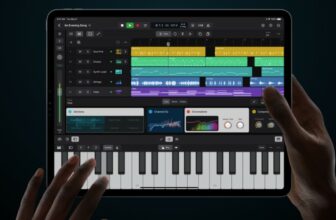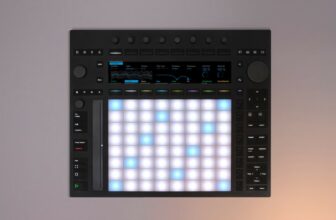What are Stems in Music?

Making a track from start to finish is a lengthy and complicated process. Depending on the complexity of the song you’re working on, you can expect to have 100 or even more tracks listed in your DAW by the time you start mixing it.
This is often unavoidable, but not exactly ideal. Navigating a music project that has too many tracks can leave you with a headache and cause you to make some bad decisions along the way.
Luckily, there’s a way to simplify your music-production workflow without taking anything away from the end product. In essence, that’s what stems are all about!
Contents
What is a stem in music?
Stems are audio recordings comprised of individual tracks that can be grouped rationally to divide a song into roughly three to eight distinctive instruments.
Drums stems, for instance, make for one single track that’s sourced from all the different drum sounds in a song.
The drums in a song can be made up of numerous individual tracks; but in the end, they will represent what the listener will perceive as the song’s drums. To group these numerous drum tracks into just one Drums audio recording is the basic principle of creating a stem in music.
Naturally, the same technique works for all sorts of categories of stems, including Vocals, Bass, Guitar, Synthesizer, Sound Effects, or any other distinguishable instrument/element of a song.
In brief, to divide a track or music project by stems is to simplify it by limiting it to its most basic, separable elements.
What is the difference between stems and multitracks?
Stems are a basic, limited number of distinguishable separated tracks that make up a song, whereas multitracks are all the individual audio tracks that were used in the making of such a song.
In a music project, stems can be often identified as the separate groups of multitracks that go into composing one of the song’s core elements. These core elements can be categorized as Vocals, Drums, Bass, etc. For each of the groups (i.e., stems) present in a music project, there may be up to tenths of multitracks.
When I’m producing a song, I find the need to create many tracks to make it sound the way I want it to. I can use as many as three separate layers just to compose a basic kick drum sound. This is great for sound quality, but not ideal for workflow.
To avoid feeling overwhelmed by the number of multitracks in a music project, I tend to divide them by stems. This way, I can quickly edit the way my Drums sound (for instance) without going into the detail of editing tenths of tracks one at a time. This makes it a lot easier to navigate any music project.
When to use stems?
Stems can be used to make producing easier, to facilitate mixing and mastering, to process multiple tracks simultaneously, to remix songs, and to share music projects with other musicians.
Let’s take a closer look at each one of these functions:
Using stems to make producing easier
If you’re a singer-songwriter working with a vocals track and a guitar track, you probably don’t need stems. But if you’re cooking an electronic banger in your DAW, you’ll most likely have up to hundreds of tracks in your music project.
For this reason, grouping multitracks into a limited set of distinguishable elements (Vocals, Drums, Bass, etc.) can help you to save a lot of time, not to mention one or two DAW-induced headaches.
Using stems to facilitate mixing and mastering
Good organization is the starting point to any quality mix or master. If you’re mixing or mastering a relatively complex song, you should divide it by stems to more easily identify the issues you need to address.
This will make your workflow a lot faster and help you to balance levels more efficiently.
Using stems to process multiple tracks simultaneously
Imagine you have a bass pattern comprised of four different bass patches, but you feel like something is missing. You want to add a bit of distortion to all the patches, so you drag a distortion effect to each one of them. This will work, but it’ll take you a lot of time.
Luckily, you can achieve the same effect by creating a Bass stem and adding the same distortion effect to all the patches simultaneously. To do so, simply group the four bass patches and drag a distortion effect to the group.
Processing multiple tracks using just one effect is a great way to save time while also creating a greater sense of cohesion between multitracks.
Using stems to remix songs
Getting a music project ready to start a remix can be overwhelming (see our article on how to remix a song). To keep a steady workflow and be organized from the beginning, start by dividing the multitracks of the song you want to remix into easily identifiable stems.
Using stems to share music projects with other musicians
One of your producer pals asked you for your most recent music project, so you export every multitrack and send him/her a folder with a couple of gigabytes. This is not ideal for two reasons: first, it will take you forever to export every multitrack. Second, because your friend will be forced to download an overwhelming number of .wav files.
This is why stems are so important for sharing music projects with other musicians. By simplifying your song into a limited number of stems, you can save a lot of time and disk storage space. More importantly, you can make everybody’s job easier.
How to export stems from a DAW?
You can export stems from a DAW by selecting just the multitracks that make up the stem and pressing export.
If your preferred DAW doesn’t have this feature, you can solo just the tracks you need and export them as the Master to achieve the same effect.
Alternatively, you can make stems even without exporting anything from your DAW. In Ableton Live, for instance, you can create a new audio file, select the input of a group of tracks (i.e., a stem), and press record.
The recording of the group will make for the stem track you require and will be immediately stored as a .wav file in your music project’s folder. If you use this technique, keep in mind the stem will not include any of the audio effects loaded into the Master track.
How and where to get music stems?
If you want to use stems for remixing, you’ll be happy to know some websites provide free downloads of the stems of popular songs.
Splice and Wavo contests are a great place for finding stems, and so are royalty-free music websites such as Epidemic Sound and Soundstripe.
Traxsource and SKIO Music also contain high-quality free stems, as well as other useful tools for DJs and producers. If you’re looking for the stems of a specific song, and you can’t find them on any of these websites, you can try your luck by searching Google, Reddit, or YouTube (there’s lots of great content in there).
How to make stems?
You can make a stem in virtually any DAW by using the ‘Group’ function, which allows you to combine multitracks into one single channel.
In most DAWs, this can be done by selecting the tracks and grouping them together (e.g. this can be done in Ableton Live by pressing Ctrl+G or Cmd+G).
Technicalities aside, making stems is about understanding how the many disparate tracks of a song can be divided into a limited number of fundamental core elements. For this purpose, I find it useful to think in terms of categories and frequencies, as these tend to go hand in hand.
If I have a super low-frequency bass and a bright slap bass in the same track, I will probably divide the sounds into two separate stems: Sub (for the low-frequency sound) and Bass (for the slap bass). However, if my bass is almost as low as the sub, I will most likely combine them into one single Bass stem. The same goes for every other category.
I also find it useful to have a Sound Effects stem in each of my tracks. While sound effects tend to be sonically diverse, they serve the same fundamental purpose in a music project, which is to add variety and momentum to different sections of the song.
To put it simply, making great stems is all about dividing the bits of a music project in a way that makes sense to you. The goal of making stems is to simplify your job as a music producer, so there’s no point in overcomplicating the process.
Summary
Whether you’re trying to make your job easier or looking to share your songs with other producers, stems make for a fundamental part of the modern-day music-production process. They’re the best way for turning extremely complex music projects into an easily approachable set of roughly six to eight different tracks.





